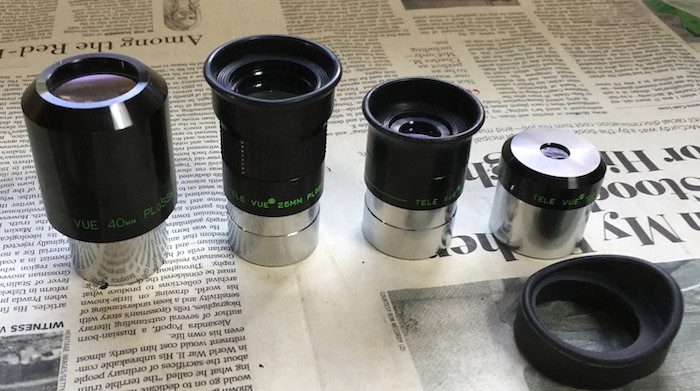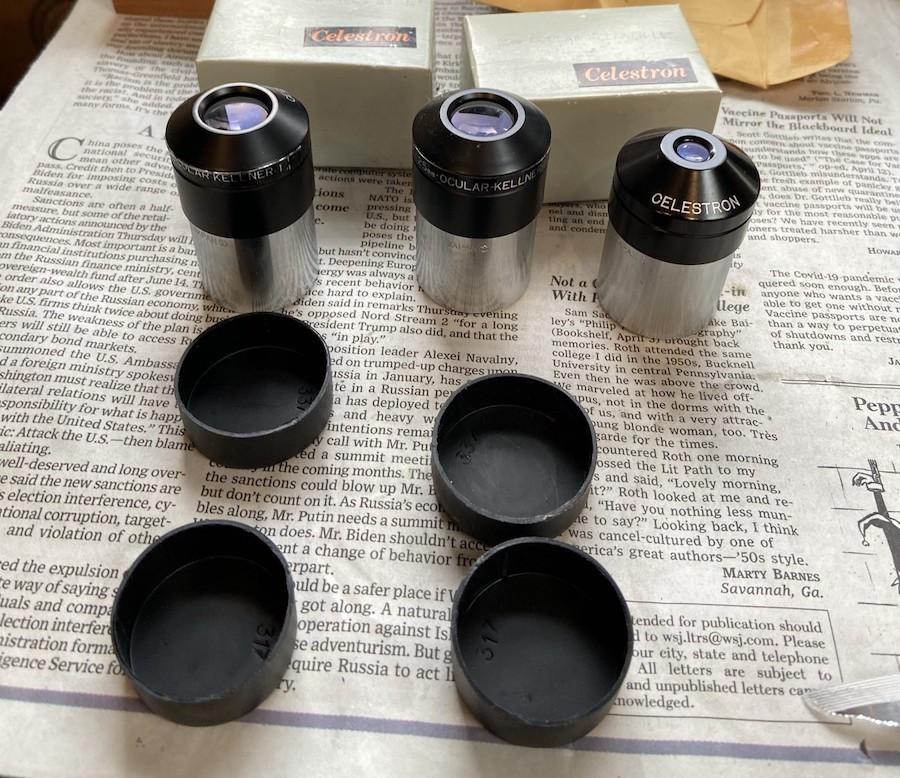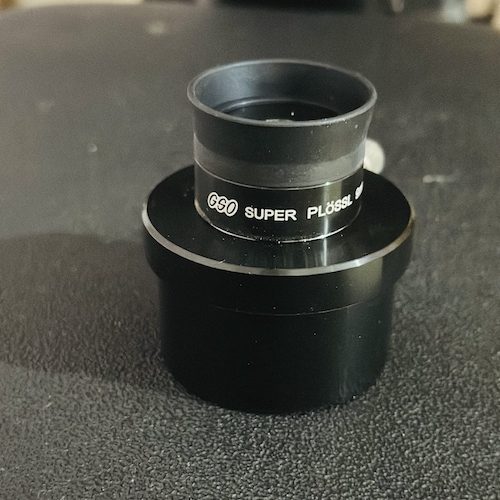

If you’ve bought your first telescope, it probably came bundled with at least one or two 3– to 4–element eyepieces, usually Plössl or Kellner.
These eyepieces used to be coveted by amateur astronomers as some of the best in their class, but they’re both over 150 years old now. Advances in optical manufacturing and coating techniques, high-fidelity computer-aided design, and lower prices have led to them largely being relegated to the “budget” eyepiece category—some folks I know actually use the lowest-quality units as dust plugs!
How They’re Built
The Kellner eyepiece design, invented in 1849, uses three lenses: a cemented convex doublet lens where light enters and a single convex eye lens at the eye end where the final image is formed. It’s an evolution of the older Ramsden design, which uses a single lens in place of the cemented doublet.
The Plossl design, which represents an evolution of the Kellner, uses a second cemented doublet lens in place of the Kellner’s single lens as the eye lens. Most Plossls use identical cemented doublet lenses for both the front and eye lens, simplifying manufacturing.
Today’s Market: Plössl Dominance and Other Options
Kellner eyepieces were a mainstay of astronomy from the 1940s through the 1990s, thanks to their vast improvements over older Huygens and Ramsden eyepiece designs. They were also ideal for the telescopes of that era, which typically had focal ratios of f/8 or slower. The Kellner was killed as much by the demanding nature of the then-new, faster Dobsonian telescopes as by economics; it became cheaper to use the same doublet lenses for Plossls than whatever money was saved by sticking with the three-element Kellner.
Plossl eyepieces have been around since 1860 but were few and far between until the 1980s, when computerized ray tracing software made it possible for them to be designed for efficient manufacture. Today, they dominate the standard eyepiece kit included with beginner telescopes.
Plossls are plentifully sold a la carte, while it’s genuinely hard to even find a Kellner sold on its own. Both Plossl and Kellner eyepieces are generally affordable, making them a good choice for beginners or those on a budget. However, the price can vary based on factors like brand, quality, and focal length.
Optical Performance of Plossls and Kellners
- Internal Reflections & Aberrations
Kellner eyepieces are slightly more prone to internal reflections than Plossls, but I think you’d be hard-pressed to notice. The Kellner design also suffers from a little more chromatic aberration and astigmatism at the edges of the field of view compared to a Plossl, so I only trust Kellners to generally perform well at focal ratios of f/8 or above (they still function down to f/6). But I can acceptably use Plossls with telescopes as fast as f/4.5, though they are best at f/6 or above.
- Field Of View
Kellners are often stopped down to a slightly narrower apparent field of view than an equivalent Plossl—perhaps 45–50 degrees instead of 50–55 degrees. However, Kellners with apparent fields as wide as 55 degrees exist, and Plossls are similarly limited to this field angle before they start to suffer from unacceptable aberrations.
- Eye Relief
Both Plossl and Kellner eyepieces are very short on eye relief. At short focal lengths, the eye lenses get even more smaller, and I literally have to jam my eyeball into the lens to see anything at all. Below around 11mm focal length, a Kellner or Plossl is usually quite uncomfortable to look through, and below 8mm in focal length, even my eyelashes get in the way, and observing through one is almost impossible.
Things to Look For When Upgrading/Buying
I see pretty much no reason to go with a Kellner over a Plossl eyepiece based on performance. However, if your telescope simply came with Kellners, it may or may not be worth upgrading, and if you are using fairly nice Kellners, a cheap Plossl ocular may actually be a step down in viewing quality. Despite what some may say, I think the difference only matters if your telescope is below around f/6, and at that point, I’d recommend you go with something a lot better than either optical design anyway.
Good Plossl and Kellner eyepieces have fully multi-coated optics for minimal glare/reflections and good light transmission. Cheaper units with plastic parts are probably going to have accordingly sloppy optical quality control. The majority of high-end Plossl and Kellner eyepieces I’ve seen were manufactured before the year 2000, though premium Plossls from companies like Tele-Vue and Masuyama still exist.
Our Best Plossl Eyepiece Guide goes into detail on some of my favorite Plossl eyepieces available today. If you’re shopping used, the Celestron Ultima/Orion Ultrascopic and similar “Masuyama-type” Plossls, along with anything made by Clave, Tele-Vue, or Vixen, are likely to be good choices.
As for Kellners, very few high-quality options are sold independently today, but most older Japan-made Kellners—often imported by companies like Celestron—compare favorably to many of the cheaper and lower-tier Plössls sold today.
Regardless of what you end up choosing, remember that Plossl and Kellner eyepieces are very uncomfortable to use with focal lengths of below 11mm and perform poorly in faster (low-f-ratio) telescopes.
My Thoughts on Plossl/Kellner Alternatives
While Plossl and Kellner eyepieces are popular and widely used, they are not the only good eyepieces available.
I’ve also tried many other types, such as wide-field Erfle oculars, sharp Nagler-type UWA eyepieces, and a variety of modified Plossl and wide-angle eyepiece designs, each with their own strengths and suited to different types of viewing. Many of these eyepieces only cost a bit more than a good Plossl or Kellner but offer significantly better performance or comfort, such as the “redline” and “goldline” oculars or a myriad of other 5- or 6-element planetary and wide-field designs. Our eyepiece buyer’s guide goes into more detail and sorts your options by price.
If you’re looking at older eyepieces to round out a collection, other simple and inexpensive designs such as the Bertele and Orthoscopic are great performers. The Orthoscopic bests even the highest-quality Plossls and Kellners in sharpness and edge-of-field correction but is limited in eye relief or field of view, while the Bertele is a wide-angle design like the Erfle with severe sharpness limitations in fast telescopes.
Ultimately, the best eyepiece for you will depend on your specific needs and preferences. I generally suggest trying out a few different eyepieces to see which one works best for you.
Distinguishing Kellner & Plossl Eyepieces
Celestron’s E-Lux 2” eyepieces are Kellners, but the 1.25” ones are Plossls. I’d call that very confusing.
When it comes to labeling inexpensive eyepiece designs, I’ve found manufacturers’ labeling to be inconsistent at best. Kellners are usually labeled as “K,” “SMA” (Super Modified Achromat), or occasionally “A.R.” (Achromatic Ramsden). Plossls are usually “PL” or “P,” though the term “Super Plossl” is popular.

In the absence of the word “Plossl,” it can be generally assumed that a “Super” eyepiece is not a Plossl. “Wide angle,” “SWA,” “Super Planetary,” and other such eyepieces are usually of the Erfle design, which uses 5 lenses (sometimes more) to improve the image.
When I spot a “Super” eyepiece with no additional verbiage, I often suspect a König: a three-element design with a 50–60 degree apparent field of view that’s basically a reversed Kellner, with a singlet field lens up front and a doublet eye lens with little space between all three elements. Similarly, “RK” and “RKE” eyepieces are of the Reversed or Rank Kellner design, which has a doublet eye lens like the König but with wider spacing and easier manufacturing tolerances. König and RKE eyepieces are a lot easier to look through and often sharper than Kellner or Plossl eyepieces.
